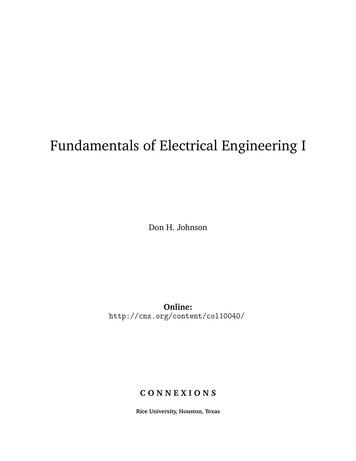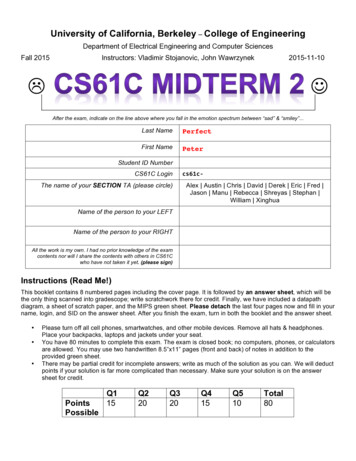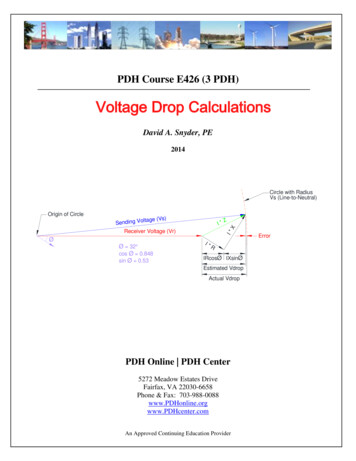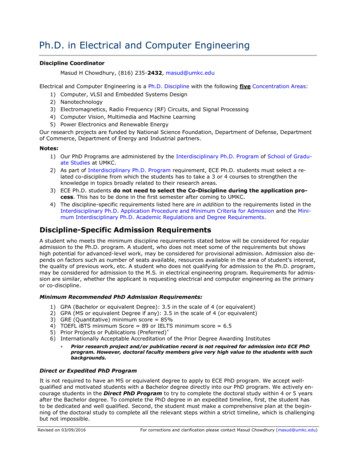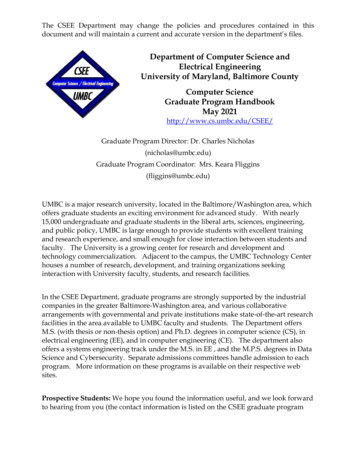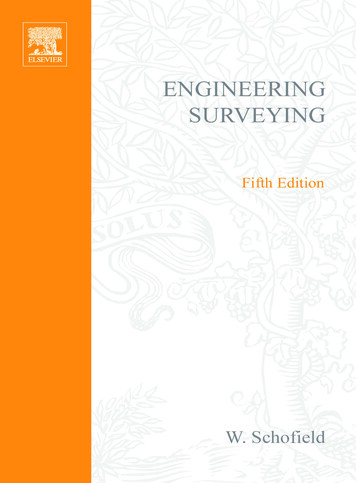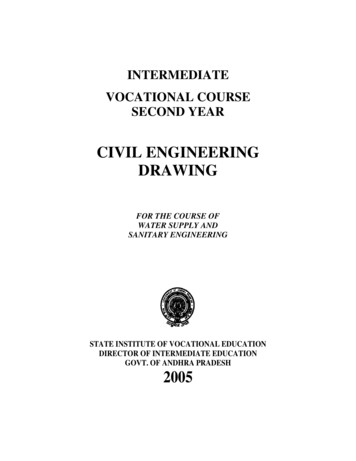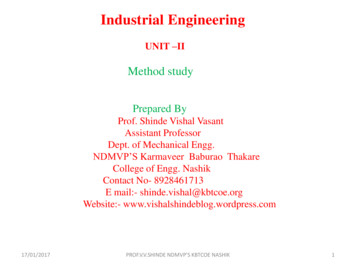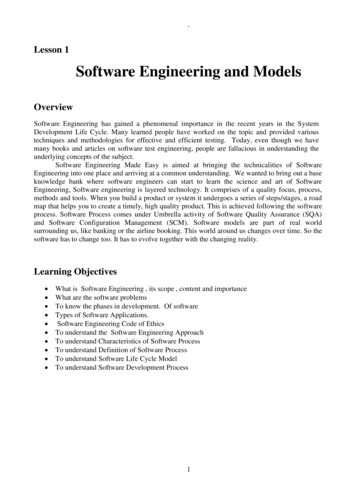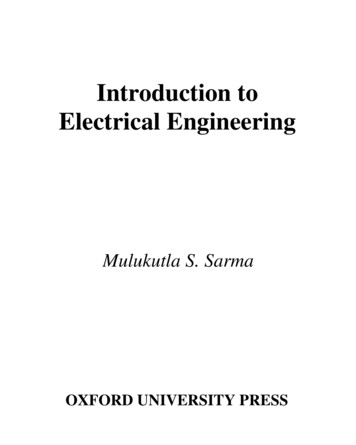
Transcription
Introduction toElectrical EngineeringMulukutla S. SarmaOXFORD UNIVERSITY PRESS
INTRODUCTION TOELECTRICAL ENGINEERING
the oxford series in electrical and computer engineeringAdel S. Sedra, Series EditorAllen and Holberg, CMOS Analog Circuit DesignBobrow, Elementary Linear Circuit Analysis, 2nd EditionBobrow, Fundamentals of Electrical Engineering, 2nd EditionBurns and Roberts, Introduction to Mixed Signal IC Test and MeasurementCampbell, The Science and Engineering of Microelectronic FabricationChen, Analog & Digital Control System DesignChen, Digital Signal ProcessingChen, Linear System Theory and Design, 3rd EditionChen, System and Signal Analysis, 2nd EditionDeCarlo and Lin, Linear Circuit Analysis, 2nd EditionDimitrijev, Understanding Semiconductor DevicesFortney, Principles of Electronics: Analog & DigitalFranco, Electric Circuits FundamentalsGranzow, Digital Transmission LinesGuru and Hiziroğlu, Electric Machinery and Transformers, 3rd EditionHoole and Hoole, A Modern Short Course in Engineering ElectromagneticsJones, Introduction to Optical Fiber Communication SystemsKrein, Elements of Power ElectronicsKuo, Digital Control Systems, 3rd EditionLathi, Modern Digital and Analog Communications Systems, 3rd EditionMartin, Digital Integrated Circuit DesignMcGillem and Cooper, Continuous and Discrete Signal and System Analysis, 3rd EditionMiner, Lines and Electromagnetic Fields for EngineersRoberts and Sedra, SPICE, 2nd EditionRoulston, An Introduction to the Physics of Semiconductor DevicesSadiku, Elements of Electromagnetics, 3rd EditionSantina, Stubberud, and Hostetter, Digital Control System Design, 2nd EditionSarma, Introduction to Electrical EngineeringSchaumann and Van Valkenburg, Design of Analog FiltersSchwarz, Electromagnetics for EngineersSchwarz and Oldham, Electrical Engineering: An Introduction, 2nd EditionSedra and Smith, Microelectronic Circuits, 4th EditionStefani, Savant, Shahian, and Hostetter, Design of Feedback Control Systems, 3rd EditionVan Valkenburg, Analog Filter DesignWarner and Grung, Semiconductor Device ElectronicsWolovich, Automatic Control SystemsYariv, Optical Electronics in Modern Communications, 5th Edition
INTRODUCTION TOELECTRICAL ENGINEERINGMulukutla S. SarmaNortheastern UniversityNew YorkOxfordOXFORD UNIVERSITY PRESS2001
Oxford University PressOxford New YorkAthens Auckland Bangkok Bogotá Buenos Aires CalcuttaCape Town Chennai Dar es Salaam Delhi Florence Hong Kong IstanbulKarachi Kuala Lumpur Madrid Melbourne Mexico City MumbaiNairobi Paris São Paulo Shanghai Singapore Taipei Tokyo Toronto Warsawand associated companies inBerlin IbadanCopyright 2001 by Oxford University Press, Inc.Published by Oxford University Press, Inc.,198 Madison Avenue, New York, New York, 10016http://www.oup-usa.orgOxford is a registered trademark of Oxford University PressAll rights reserved. No part of this publication may be reproduced,stored in a retrieval system, or transmitted, in any form or by any means,electronic, mechanical, photocopying, recording, or otherwise,without the prior permission of Oxford University Press.Library of Congress Cataloging-in-Publication DataSarma, Mulukutla S., 1938–Introduction to electrical engineering / Mulukutla S. Sarmap. cm. — (The Oxford series in electrical and computer engineering)ISBN 0-19-513604-7 (cloth)1. Electrical engineering. I. Title. II. Series.TK146.S18 2001621.3—dc2100-020033Acknowledgments—Table 1.2.2 is adapted from Principles of Electrical Engineering (McGraw-Hill Series in Electrical Engineering), by Peyton Z.Peebles Jr. and Tayeb A. Giuma, reprinted with the permission of McGraw-Hill, 1991; figures 2.6.1, 2.6.2 are adapted from Getting Started withMATLAB 5: Quick Introduction, by Rudra Pratap, reprinted with the permission of Oxford University Press, 1998; figures 4.1.2–4.1.5, 4.2.1–4.2.3,4.3.1–4.3.2, are adapted from Electric Machines: Steady-State Theory and Dynamic Performance, Second Edition, by Mulukutla S. Sarma, reprintedwith the permission of Brooks/Cole Publishing, 1994; figure 4.6.1 is adapted from Medical Instrumentation Application and Design, by John G. Webster,reprinted with the permission of John Wiley & Sons, Inc., 1978; table 4.6.1 is adapted from “Electrical Safety in Industrial Plants,” IEEE Spectrum, byRalph Lee, reprinted with the permission of IEEE, 1971; figure P5.3.1 is reprinted with the permission of Fairchild Semiconductor Corporation; figures5.6.1, 6.6.1, 9.5.1 are adapted from Electrical Engineering: Principles and Applications, by Allen R. Hambley, reprinted with the permission of PrenticeHall, 1997; figure 10.5.1 is adapted from Power System Analysis and Design, Second Edition, by Duncan J. Glover and Mulukutla S. Sarma, reprintedwith the permission of Brooks/Cole Publishing, 1994; figures 11.1.2, 13.2.10 are adapted from Introduction to Electrical Engineering, Second Edition,by Clayton Paul, Syed A. Nasar, and Louis Unnewehr, reprinted with the permission of McGraw-Hill, 1992; figures E12.2.1(a,b), 12.2.2–12.2.5, 12.2.9–12.2.10, 12.3.1–12.3.3, 12.4.1, E12.4.1, P12.1.2, P12.4.3, P12.4.8, P12.4.12, 13.1.1–13.1.8, 13.2.1–13.2.9, 13.2.11–13.2.16, 13.3.1–13.3.3, E13.3.2,13.3.4, E13.3.3, 13.3.5–13.3.6 are adapted from Electric Machines: Steady-State Theory and Dynamic Performance, Second Edition, by Mulukutla S.Sarma, reprinted with the permission of Brooks/Cole Publishing, 1994; figure 13.3.12 is adapted from Communication Systems Engineering, by John G.Proakis and Masoud Salehi, reprinted with the permission of Prentice Hall, 1994; figures 13.4.1–13.4.7, E13.4.1(b), 13.4.8–13.4.12, E13.4.3, 13.4.13,13.6.1 are adapted from Electric Machines: Steady-State Theory and Dynamic Performance, Second Edition, by Mulukutla S. Sarma Brooks/ColePublishing, 1994; figures 14.2.8, 14.2.9 are adapted from Electrical Engineering: Concepts and Applications, Second Edition, by A. Bruce Carlson andDavid Gisser, reprinted with the permission of Prentice Hall, 1990; figure 15.0.1 is adapted from Communication Systems, Third Edition, by A. BruceCarlson, reprinted with the permission of McGraw-Hill, 1986; figures 15.2.15, 15.2.31, 15.3.11 are adapted from Communication Systems Engineering,by John G. Proakis and Masoud Salehi, reprinted with the permission of Prentice Hall, 1994; figures 15.2.19, 15.2.27, 15.2.28, 15.2.30, 15.3.3, 15.3.4,15.3.9, 15.3.10, 15.3.20 are adapted from Principles of Electrical Engineering (McGraw-Hill Series in Electrical Engineering), by Peyton Z. PeeblesJr. and Tayeb A. Giuma, reprinted with the permission of McGraw-Hill, 1991; figures 16.1.1–16.1.3 are adapted from Electric Machines: Steady-StateTheory and Dynamic Performance, Second Edition, by Mulukutla S. Sarma, reprinted with the permission of Brooks/Cole Publishing, 1994; table16.1.3 is adapted from Electric Machines: Steady-State Theory and Dynamic Performance, Second Edition, by Mulukutla S. Sarma, reprinted with thepermission of Brooks/Cole Publishing, 1994; table 16.1.4 is adapted from Handbook of Electric Machines, by S. A. Nasar, reprinted with the permissionof McGraw-Hill, 1987; and figures 16.1.4–13.1.9, E16.1.1, 16.1.10–16.1.25 are adapted from Electric Machines: Steady-State Theory and DynamicPerformance, Second Edition, by Mulukutla S. Sarma, reprinted with the permission of Brooks/Cole Publishing, 1994.Printing (last digit): 10 9 8 7 6 5 4 3 2 1Printed in the United States of Americaon acid-free paper
To my grandchildrenPuja SreeSruthi LekhaPallavi Devi***and those to come
This page intentionally left blank
CONTENTSList of Case Studies and Computer-Aided AnalysisPreface xvOverview xxiPART 11ELECTRIC CIRCUITSCircuit Concepts1.11.21.31.41.51.61.723Electrical Quantities 4Lumped-Circuit Elements 16Kirchhoff’s Laws 39Meters and Measurements 47Analogy between Electrical and Other Nonelectric Physical SystemsLearning Objectives 52Practical Application: A Case Study—Resistance Strain Gauge 52Problems 53Circuit Analysis Techniques2.12.22.32.42.52.62.72.83xiii66Thévenin and Norton Equivalent Circuits 66Node-Voltage and Mesh-Current Analyses 71Superposition and Linearity 81Wye–Delta Transformation 83Computer-Aided Circuit Analysis: SPICE 85Computer-Aided Circuit Analysis: MATLAB 88Learning Objectives 92Practical Application: A Case Study—Jump Starting a CarProblems 94Time-Dependent Circuit Analysis3.13.23.33.45092102Sinusoidal Steady-State Phasor AnalysisTransients in Circuits 125Laplace Transform 142Frequency Response 154103vii
viiiCONTENTS3.53.63.73.84Three-Phase Circuits and Residential Wiring4.14.24.34.44.54.6PART 25Three-Phase Source Voltages and Phase Sequence 198Balanced Three-Phase Loads 202Measurement of Power 208Residential Wiring and Safety Considerations 212Learning Objectives 215Practical Application: A Case Study—Physiological Effects of Current andElectrical Safety 216Problems 218Analog Building Blocks and Operational Amplifiers268Digital Building Blocks 271Digital System Components 295Computer Systems 316Computer Networks 320Learning Objectives 325Practical Application: A Case Study—Microcomputer-ControlledBreadmaking Machine 325Problems 326Semiconductor Devices7.17.27.3223The Amplifier Block 224Ideal Operational Amplifier 229Practical Properties of Operational Amplifiers 235Applications of Operational Amplifiers 244Learning Objectives 256Practical Application: A Case Study—Automotive Power-Assisted SteeringSystem 257Problems 258Digital Building Blocks and Computer Systems6.16.26.36.46.56.67198ELECTRONIC ANALOG AND DIGITAL SYSTEMS5.15.25.35.45.55.66Computer-Aided Circuit Simulation for Transient Analysis, AC Analysis, andFrequency Response Using PSpice and PROBE 168Use of MATLAB in Computer-Aided Circuit Simulation 173Learning Objectives 177Practical Application: A Case Study—Automotive Ignition System 178Problems 179339Semiconductors 339Diodes 340Bipolar Junction Transistors358
ixCONTENTS7.47.57.67.78Transistor Amplifiers8.18.28.38.48.58.68.79PART 3393422Transistor Switches 423DTL and TTL Logic Circuits 427CMOS and Other Logic Families 431Learning Objectives 437Practical Application: A Case Study—Cardiac Pacemaker, a BiomedicalEngineering Application 438Problems 439ENERGY SYSTEMSAC Power Systems10.110.210.310.410.511380Biasing the BJT 394Biasing the FET 395BJT Amplifiers 399FET Amplifiers 405Frequency Response of Amplifiers 409Learning Objectives 414Practical Application: A Case Study—Mechatronics: Electronics Integratedwith Mechanical Systems 414Problems 415Digital Circuits9.19.29.39.49.510Field-Effect Transistors 367Integrated Circuits 378Learning Objectives 379Practical Application: A Case Study—Electronic Photo FlashProblems 380451Introduction to Power Systems 452Single- and Three-Phase Systems 455Power Transmission and Distribution 460Learning Objectives 466Practical Application: A Case Study—The Great Blackout of 1965Problems 468Magnetic Circuits and Transformers11.111.211.311.411.511.6471Magnetic Materials 472Magnetic Circuits 475Transformer Equivalent Circuits 479Transformer Performance 486Three-Phase Transformers 490Autotransformers 492466
412.512.612.713PART 4553Elementary Concepts of Rotating Machines 553Induction Machines 563Synchronous Machines 582Direct-Current Machines 594Learning Objectives 610Practical Application: A Case Study—Wind-Energy-ConversionSystems 610Problems 612INFORMATION SYSTEMSSignal Processing14.114.214.314.414.515505Basic Principles of Electromechanical Energy Conversion 505EMF Produced by Windings 514Rotating Magnetic Fields 522Forces and Torques in Magnetic-Field Systems 526Basic Aspects of Electromechanical Energy Converters 539Learning Objectives 540Practical Application: A Case Study—Sensors or Transducers 541Problems 542Rotating Machines13.113.213.313.413.513.614Learning Objectives 494Practical Application: A Case Study—Magnetic Bearings for SpaceTechnology 494Problems 495625Signals and Spectral Analysis 626Modulation, Sampling, and Multiplexing 640Interference and Noise 649Learning Objectives 658Practical Application: A Case Study—Antinoise Systems, NoiseCancellation 658Problems 659Communication Systems15.115.215.315.415.5666Waves, Transmission Lines, Waveguides, and Antenna Fundamentals 670Analog Communication Systems 685Digital Communication Systems 710Learning Objectives 730Practical Application: A Case Study—Global Positioning Systems 731Problems 732
CONTENTSPART 516CONTROL SYSTEMSBasic Control Systems16.116.216.316.416.5747Power Semiconductor-Controlled Drives 748Feedback Control Systems 779Digital Control Systems 805Learning Objectives 814Practical Application: A Case Study—Digital Process ControlProblems 816815Appendix A: References 831Appendix B: Brief Review of Fundamentals of Engineering(FE) Examination 833Appendix C: Technical Terms, Units, Constants, and ConversionFactors for the SI System 835Appendix D: Mathematical Relations 838Appendix E: Solution of Simultaneous Equations 843Appendix F: Complex Numbers 846Appendix G: Fourier Series 847Appendix H: Laplace Transforms 851Index 855xi
This page intentionally left blank
LIST OF CASE STUDIES ANDCOMPUTER-AIDED ANALYSISCase 14.515.516.5Practical Application: A Case Study—Resistance Strain Gauge 52Practical Application: A Case Study—Jump Starting a Car 92Practical Application: A Case Study—Automotive Ignition System 178Practical Application: A Case Study—Physiological Effects of Current and Electrical Safety216Practical Application: A Case Study—Automotive Power-Assisted Steering System 257Practical Application: A Case Study—Microcomputer-ControlledBreadmaking Machine 325Practical Application: A Case Study—Electronic Photo Flash 380Practical Application: A Case Study—Mechatronics: Electronics Integrated with MechanicalSystems 414Practical Application: A Case Study—Cardiac Pacemaker, a Biomedical EngineeringApplication 438Practical Application: A Case Study—The Great Blackout of 1965 466Practical Application: A Case S
the oxford series in electrical and computer engineering Adel S. Sedra, Series Editor Allen and Holberg, CMOS Analog Circuit Design Bobrow, Elementary Linear Circuit Analysis, 2nd Edition Bobrow, Fundamentals of Electrical Engineering, 2nd Edition Burns and Roberts, Introduction to Mixed Signal IC Test and Measurement Campbell, The Science and Engineering of Microelectronic Fabrication

